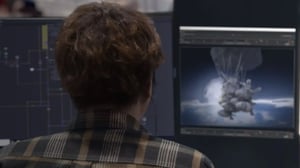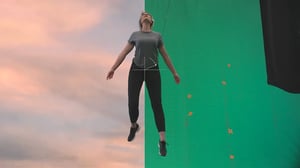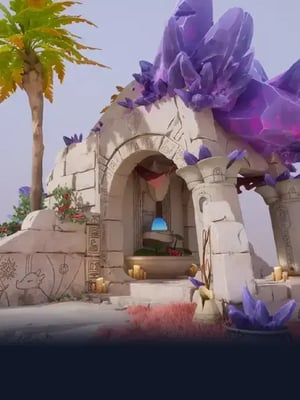
Roto Artist
TABLE OF CONTENTS
What does a roto artist do?
Roto artists digitally trace areas within live-action frames (known as a plate) where CG characters, backgrounds, or effects will be integrated with the live-action footage. They work closely with Compositors. Roto artists also create roto mattes, similar to silhouettes, within the frame to allow for CG hold-outs. If the sequence involves camera movement, roto artists must work frame-by-frame to ensure the silhouettes continue to match the plate. This technique is known as rotoscoping.
Roto artist job description
Roto artist job description
A lot of what a roto artist does is behind the scenes, so what you see in the final film does not really reflect their work. Much like a Compositor, their role is to help make each shot and all its components seamlessly fit together. They create mattes to help other artists build up a shot in different layers (either in front, alongside, or behind something in the live-action plate) and provide hold-outs that help other artists add shadows and reflections that match the plate.
Role & responsibilities of a roto artist in the film industry:
- Use Silhouette, Nuke to create and track roto shapes and lines for various elements within a shot
- Create roto mattes for Compositors and foreground mattes for Animators with a comprehensive understanding of how these mattes will be used
- Shape creation/editing; shape animation by hand and with trackers; and shape compositing, fill modes, and opacity settings
- Maintaining consistency of visuals and style throughout the production
- Basic green and blue screen compositing

How much does a roto artist make?
According to Glassdoor, the average wage for a roto artist is around USD $84,000 but this will vary depending on location, experience, and studio.
Skills required to become a roto artist
Roto artists require a strong attention to detail along with sound technical and creative skills. The VFX industry is a highly collaborative environment so a roto artist must be able to work well in a team, and have a solid understanding of the VFX pipeline.
Film studios may look for the following skills in a roto artist:
- Strong eye for color and understand grain structure and successfully de-grains scans and re-grains paintwork for further use
- Extensive understanding of 2D and 3D tracking and is able to create accurate, steady tracks
- Able to handle complex shots with heavy motion blur, defocus, hair, fur, lots of layers, etc.
- Drawing ability, accurate tracing skills with high attention to detail
What software and tools do roto artists use?
The software used for 3D animation is highly specialized. The more platforms you are trained in, the more valuable you will be to an employer. 3D animators may need knowledge of a combination of the following software.

Maya is a comprehensive 3D animation software used for creating detailed models, animations, and visual effects. It's popular in film, TV, and game development for its powerful tools.

Nuke is a node-based digital compositing and visual effects application first developed by Digital Domain and used for television and film post-production

Adobe After Effects is a digital visual effects, motion graphics, and compositing application developed by Adobe Inc
A day in the life of a roto artist
If you want to work as a roto artist, you need to understand every step of the VFX pipeline.
The visual effects production pipeline refers to the various stages of production required to add visual effects to a film of TV show. The pipeline organizes each department so that every artist knows their role, and a production can move along within the allocated timeline.
How to become a roto artist
To get a job in VFX, you’ll need an amazing demo reel! Here are some tips to get you started. Don't forget to check out VFX supervisor Jorge Razon's top demo real and interview tips.
- Students, keep your reel < 1 min. If you have 1–2 years experience, < 2 mins.
- Include any production experience you have.
- Breakdowns are good but keep it to 3–4 quick wipes.
- Always Include breakdown descriptions where applicable.
- Use Vimeo— the video quality is better than YouTube.
- Everything in your reel should be 10/10, do not include mediocre work.
- Keep the music fairly conservative, nobody listens to it anyway.
- Watch your reel a lot of times and look for comp, edit, frame or spelling errors.
- Get feedback from at least 3 instructors or industry pros before releasing online.
- Show reference footage when applicable.
- Share your reel with the world via LinkedIn, Facebook, Instagram.
Almost all schools train students to become generalists. If you are applying for VFX jobs at a small studio with less than 30 artists, they will most likely want a generalist. Larger studios will have separate departments, so a more specialized set of skills is desirable.

Ready to Start Your Film & Games Journey?
Download our course guide to see how we can help you on your pathway to your dream career.
Industry Pathways
Welcome to our brand new series, Industry Paths. Tune in to meet our professional mentors from across the film, games, and visualization industries and hear directly from them about how they got started, what a day in their life looks like, and why they do what they do. In this episode, you'll hear from Daniel Hourigan, CG Spectrum's VFX Manager.
Tips to break into the VFX industry
Increase your chances of getting hired with these strategies for success:
Download software
Trial VFX programs like Maya, Nuke or Houdini Apprentice.
Build skills
Build the skills companies are listing on job sites. For more support, enroll in a reputable course. CG Spectrum’s FX courses include mentorship from VFX pros and an industry-led curriculum.
Watch trends
Online tutorials, webinars, and events can help keep your skills fresh.
Network
Networking is vital. Familiarize yourself with the industry and build your community. Interact online and in real life with industry pros who might offer advice, insights, or job opportunities.
Intern
Internships at VFX or game studios can help you break into the industry. It’s one way to gain hands-on experience, network, and experience studio life.
Join contests
Practice your skills and create assets for your reel by participating in contests and challenges on sites like The Rookies, and ArtStation.
Share work
Social media is great for showcasing work, building an audience, having your work shared by others, and seen by potential clients and collaborators.


